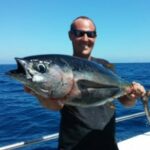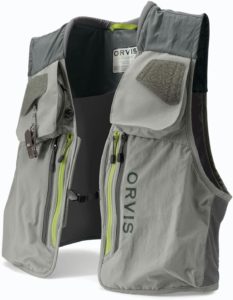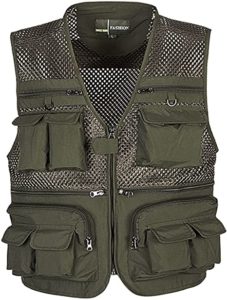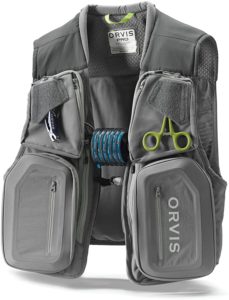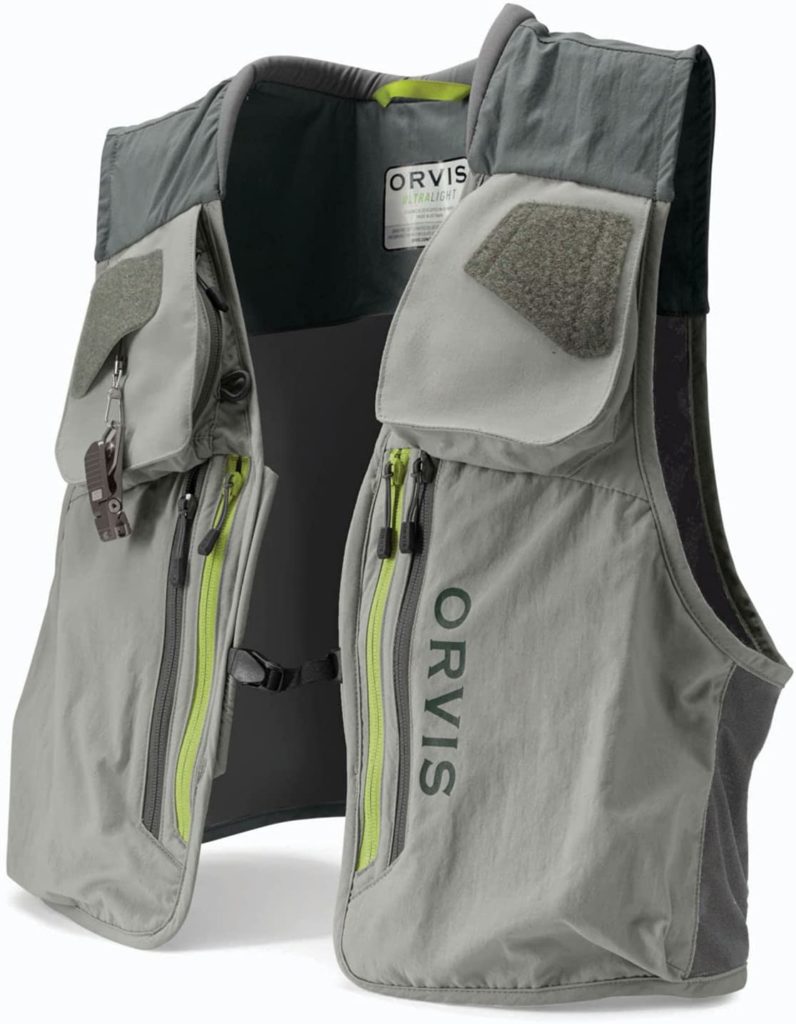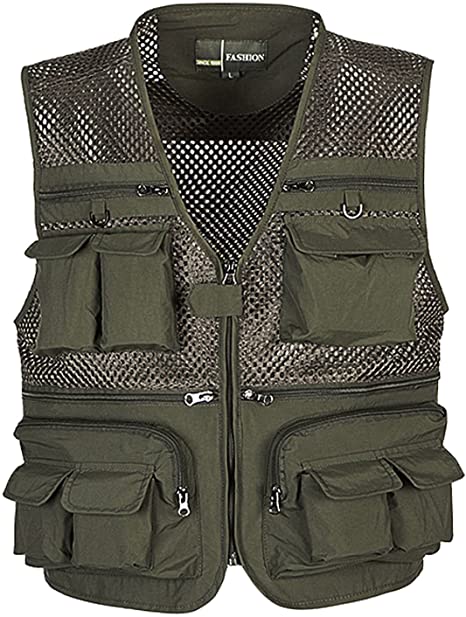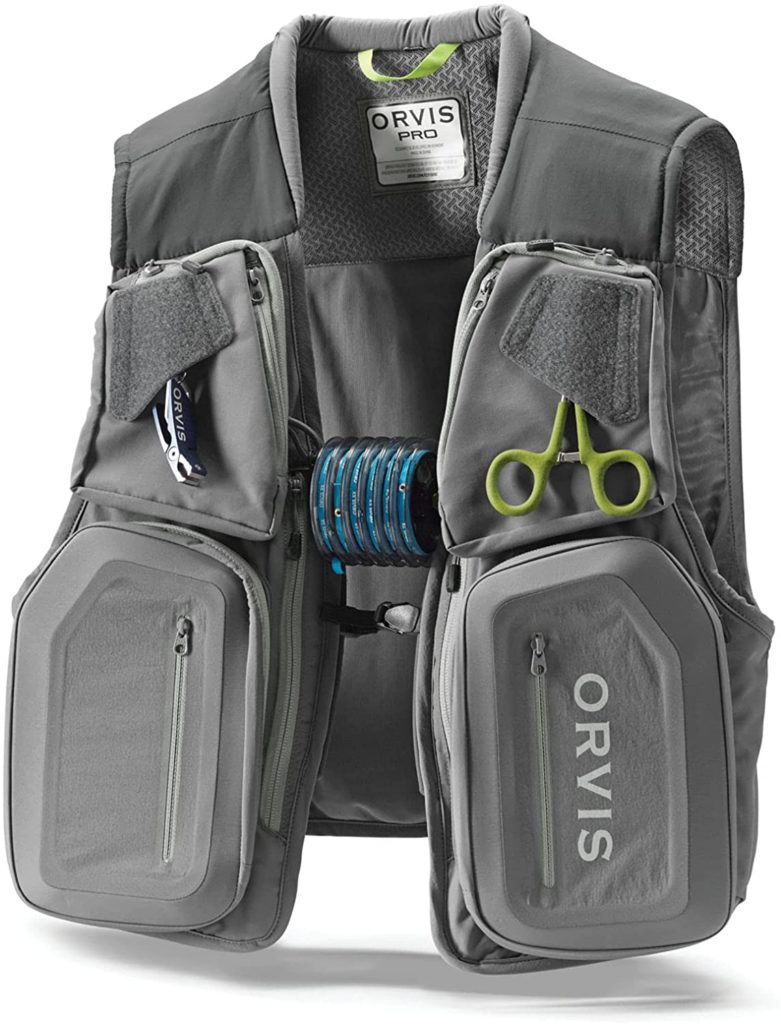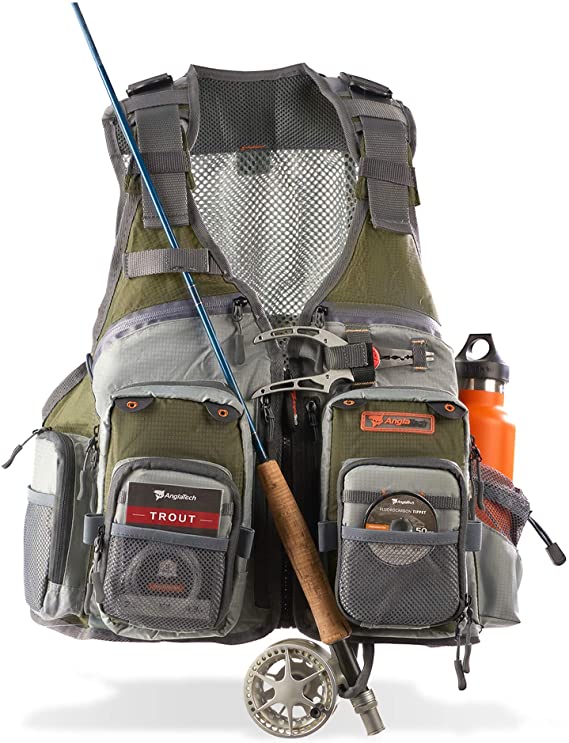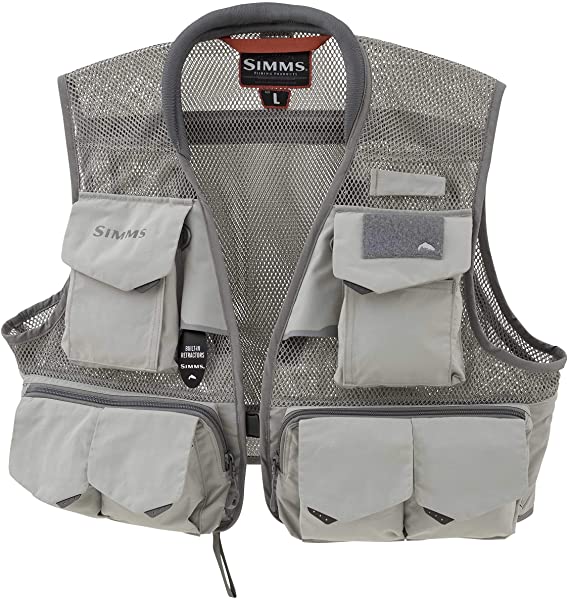Why Do I Need A Fly Fishing Vest?
There are two things about fly fishing every angler immediately learns on their first trip into the water:
- Wading is work
- Trout are smart
You’re never sure which bait is going to convince a cautious fish to bite, or when you’re going to snag a lure on an underwater branch. If you spend time wading in and out of the water (see the best wading boots for fly fishing here) to change out your rig, you’re going to wear yourself out long before you’ve caught your limit.
This is exactly why most anglers take at least some extra gear with them out into the water.
Vests have been a go-to for decades, and for good reason. Chest bags kill your neck after a few hours. Arm packs make your non-casting arm ache. Shoulder-straps make your muscles stiff and waist packs get wet if you fish in deeper streams.
Vests distribute the weight of your gear evenly across both shoulders. Modern designs are form-fitting, leaving your arms free to cast perfect flips and loops. Some styles are cut high enough to stay out of deep water.
Vests can support multiple pockets, clips, and hooks to store pretty much anything you could need. Modern styles are made of superior, light-weight, fully-breathable materials that resist water and dry quickly.
When it boils down to comfort, utility, and versatility, the vest reigns supreme.
You might also want to check out this article about best fly fishing reels.
Best Ultralight Fly Fishing Vest
Orvis knows how to combine comfort with utility, and their Ultralight Vest is the perfect example of this. This is a no-fail pick when you need to stay light.
Check Today's PriceMaterial: DWR-treated woven nylon. Collar and mesh: polyester/spandex
Weight: 13.12 ounces
Pockets: 11 total – 6 chest, 4 inside, 1 back
This is about the best ultralight fly fishing vest you can find. At less than a pound, this vest lets you stay out on the water longer while still packing all of your favorite gear.
It also features padding in the neck and shoulders, reducing chafing and sore muscles. The stretchable spandex/polyester mesh sides allow for maximum casting flexibility and airflow in the summer heat.
Four large chest pockets are layered over one another, making it far less bulky than other models. Two of these pockets contain additional mesh compartments to keep your smaller items organized and easily accessible.
The material is DWR treated, helping to shed water and dry quickly. The best part is the huge back pocket – you could store a whole lunchbox back there!
Best Budget Fly Fishing Vest
If you are looking for a wallet-friendly vest that comes with plenty of style options, you need to check out Flygo’s line of summer outdoor vests. Great for both beginners or avid anglers.
Check Today's PriceMaterials: Cotton linen, polyester, mesh
Weight: <1lb.
Pockets: 16 – 9 cargo, 4 mesh front, 2 inside, 1 back
Offering three different styles and a plethora of color options, Flygo vests are so affordable you might be tempted to buy one for multiple occasions (I know I am!). They not only look good, but their versatility and utility make them a downright steal for the money.
The mesh style is best suited for fly fishing, in my opinion. It features 16 pockets positioned to stay out of your way while casting. It’s lightweight, extremely breathable, durable, and dries out quickly. Great for those drizzly or damp early morning starts.
The front cargo pockets are easy to get into, and the back pocket takes up nearly the entire back of the vest. It also features two D-rings on the front for attachments and a velcro strap across the front zipper that you could use as a rod holder in a pinch.
This vest is great for spring, summer, or early fall fishing.
Best Premium Fly Fishing Vest
When it comes to a professional performance vest, it’s hard to beat the Orvis PRO Vest. It’s sleek, durable, and stylish. A must-have for any serious angler.
Check Today's PriceMaterials: Nylon
Weight: 1.4 lbs
Pockets: 18 – 10 exterior, 6 interior, 2 back
Sitting at the very top of the line is the Orvis PRO fly fishing vest. Although higher on the budget spectrum, this vest spares no expense when it comes to comfort, efficiency, and durability.
The sleek and classy design isn’t just for show. A front clasp replaces a traditional front zipper, meaning you’ll never be caught struggling with stuck or torn zippers. The vest is also adjustable, ensuring that perfect close fit.
The front pockets are compression-molded to increase rigidity. This means your more delicate gear is protected from accidental crushing and it makes it easier to manipulate when retrieving items. Eighteen total pockets let you stay organized.
The PRO vest also takes long fishing hours into consideration. Lofted inner mesh lining and extra padding around the collar and shoulders lets you carry all the gear you need in complete comfort.
The nylon fabric is abrasion-resistant, DWR coated, and lightweight. The open front makes this model breathable and the high-cut lets you wade into deeper water without soaking the vest. The streamlined pocket positioning gives you maximum freedom to cast.
Best Casual Fly Fishing Vest
The Anglatech fly fishing vest is a great old-school-style vest well-suited to the casual angler. Recommended for those who like to fish with a cold one at your side.
Check Today's PriceMaterials: Nylon, mesh
Weight: around 1lb.
Pockets: 12+ – 7 front, 4 inside, 1 back, plus multiple mesh pockets and a side drink carrier
This mid-budget vest is designed more for the casual fly fisher. It features tons of pockets inside and out, a velcro nipper holder, and water-resistant material.
Besides the cargo-style pockets, the vest also has several mesh pouches. Angletech put pouches or pockets wherever they could. Some anglers might find his vest a little bit bulky, but the real seller is the water bottle holder.
It also has a handy rod holder and sling for hands-free work. The front two pockets pop down to reveal a mini “shelf” with a foam insert for flies. This is removable if you’d prefer an extra fly box, but the box has to be quite small to fit.
There are adjustable straps at both the waist and shoulders. While it’s styled for both men and women, it might not adjust down far enough for folks with smaller builds.
Best Summer Vest for Optimal Storage
One of the most well thought-out fly fishing vests in the hobby. A cool, lightweight vest that lets you pack to your heart’s content. It has everything you will need and nothing you don’t!
Check Today's PriceMaterial: DWR finished nylon fabric with polyester mesh lining
Weight: 15 ounces
Pockets: 20 – 10 exterior, 8 interior, 2 back
The Simms Headwaters Pro Mesh Fishing Vest is the ultimate example of what happens when pro fishers design fishing gear: perfection!
This vest boasts 20 well-sized, roomy pockets to easily store bulkier fly boxes. Multiple interior pockets keep iPhones, electronics, and other sensitive gear safe and dry. The number and utility of the pockets make organizing a cinch.
The fabric is high-quality nylon and polyester treated for water resistance. It’s lightweight, and the collar is padded for ultimate comfort.
It may be a little on the pricier side, but it gives you back every penny with interest. There’s nothing useless or unnecessary on this vest. It comes with two plastic coil retractors built-in, so you don’t have to worry about adding extra zingers for your nippers and hemostat.
The cut of this vest rides high off the waist. It has both a rod holder, a reel sling, and a D-ring on the back for your net.
Simm’s warranty for this vest is the icing on this already sweet cake. If you’re not happy for any reason you can send it back for free. If you are happy, and put this rugged vest to the test, they will make repairs on it for you.
There’s really very little not to love about this vest!
Factors to Consider When Choosing a Vest
Material Quality
Fly fishing vests have to survive a lot of wear and tear, as well as hold up to the elements. There’s nothing more annoying than fraying seams, torn pockets, and jammed zippers.
Vest materials need to breathe, especially during the spring and summer seasons, and they must be slim and light for you to cast freely.
Vests also need to hold up to moisture. Cotton weave or other natural materials are the old stand-by for vests, but unless they’re treated to make them water-resistant, they’ll easily develop mold and mildew.
Modern materials like rayon, polyester, spandex fiber, and nylon are more resistant to mold and mildew, and a good quality weave will breathe well. These materials are also less bulky, dry more quickly, and take up less space in packing.
Weight
How much gear are you going to pack on you? How long can you stand and cast for? Knowing how you like to fish will help you decide how much weight you’re willing to tolerate on your trip.
Bulkier vests made of heavier canvas or those with more pockets are generally going to weigh more. You may think a heavier vest is better for fishing in cooler weather, but vests aren’t meant to keep you warm – they’re for gear storage.
Summer vests feature lots of mesh netting, which are light and breathe well.
Gear alone can weigh up to 15 – 20 pounds. So, when choosing the weight of a vest, consider what weather you’re planning to fish in and how much gear you’d like to take with you.
Number & Size of Pockets
How much gear you want to have on you, the size of your fly boxes, and how organized you are will determine how many pockets you’ll want on your fly fishing vest, and what size they need to be.
A vest with too small or too few pockets won’t hold everything you need. Too many, or too big of pockets will either interfere with your cast or have you playing musical pockets.
Rod Holder
Most anglers consider rod holders an essential feature of their vests. They let you strap your rod to your vest, leaving your hands free to change out flies. Otherwise, you’ll have to tuck your rod up under your arm or find some other means to hold it.
If you’re like me and like to catch trout right after the hatchery releases them (when they’re super easy), then you’re probably fine without a rod holder. If you prefer the challenge of wilier fish, or you frequently change flies, then you will definitely want a vest with a rod holder.
Check this article for the most expensive fishing rods.
Style
What style of vest you choose really boils down to your personal tastes and what features you find most useful. Comfort plays a major role. So does the weather and your preferred casting techniques.
Each style comes with pros and cons. Mesh styles are great for summer use, but the mesh material can easily snag on low-hanging branches and bushes.
The old-school Poplin style is a longer-cut vest with a V-nec. While the chest pockets are easier to see down into, the low waist will get wet if you wander into deep water.
High-cut styles are for deep-water anglers, but the upper front pockets on these may be set too far under the chin to be comfortable to see into.
When it comes to men’s and women’s styles, there isn’t a whole lot of difference. Many women anglers I know prefer men’s or unisex vests.
Cost
How much you should spend on a vest depends on your budget and how serious you are in the hobby.
If you’re more the casual weekend fisher you likely can get away with something on the lower end of the budget spectrum. If you’re a frequent angler or a competitive pro, definitely drop a little extra cash for a quality vest.
Beware of going too cheap. It’s better to save up for a good vest than to purchase one that chaffs or falls apart. In the end, you should be satisfied with your vest.
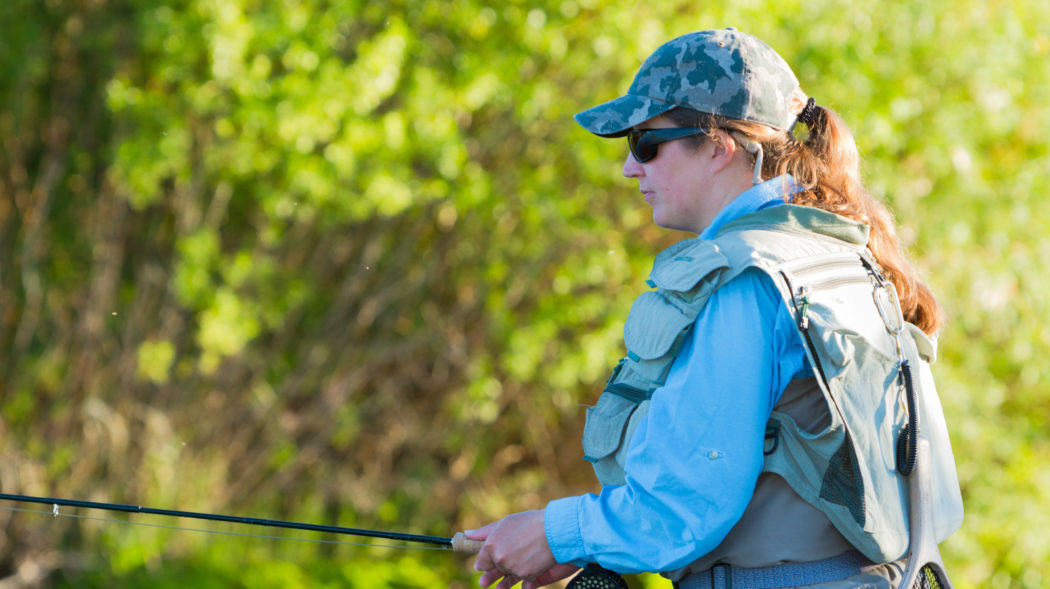
Fly Fishing Vest FAQ
Here are the answers to the most common questions about fly fishing vests.
How many pockets is the sweet spot for a fly fishing vest?
Most anglers seem to prefer between 11 and 20 pockets, depending on their gear and how organized they are.
How should a fly fishing vest fit?
A good vest should fit snug against the body, allowing complete freedom of mobility for casting.
What are the differences between budget and high-end fly fishing vests?
Short answer: Everything.
Economy vests are designed by people who know nothing about fly fishing needs. They’re fine if you fish no more than maybe twice a year, but are almost guaranteed to fall apart after their first season.
Unless you like the idea of patching up your vest every other trip, avoid them.
Quality vests are made by anglers for anglers. They know how vests are expected to perform and what anglers need out of them.
High-end vests are durable, treated against water damage, allow for maximum mobility, and provide the right amount of storage space. They may be a little on the high end, but a good vest pays for itself through many years of reliable use.
What should I pack in my fly fishing vest?
What an angler packs into their vest and how is a very personal matter. Most anglers pack at the very least:
- Fly boxes and an assortment of flies
- Sinkers
- Water bottle
- Polarized sunglasses
- Nippers and/or pliers
- Sunscreen
- Net
Optionally, you can also include:
- A spare fly box for flies that are (or are not) working that day
- Drying compound
- Hemostat
- Tippets
- Extra reel
- Lunch and a water bottle
In Summary
A fly fishing vest keeps your eyes on where the fish are. Wearing one eliminates the need to wade back to shore to re-tie.
A good vest is well-built, breathable, fits snugs to the body, has ample storage pockets (from 11 to 20 is the sweet spot), and isn’t so bulky that it throws off your swing. A good vest will last you years.
The style you choose depends on what time of year you fish, the amount of gear you want to bring, and what and how you like to pack. A mesh vest is ideal for spring and summer. Non-mesh styles are better for colder weather or increased storage.
At bare-bones minimum, you should pack in your vest:
- Fly boxes
- Extra line
- Sinkers/weights
- Nippers and/or fishing pliers
- Sunscreen & shades
- Net
Above are examples of great-quality vests for a range of budgets and style preferences. The vest you choose should be one you enjoy wearing – one that will give you many seasons of great fishing.
As an Amazon Associate, Fishermen's Angle earns from qualifying purchases. We get commissions for purchases made through links in this post.
